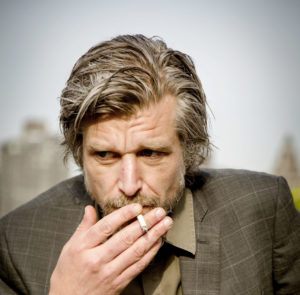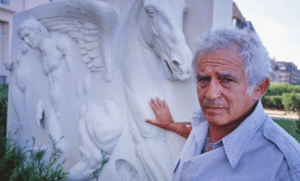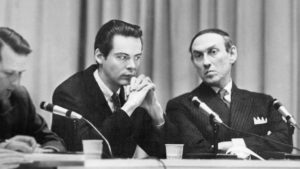Jack Kerouac, who would have been 100 tomorrow, was the sort of male literary celebrity America doesn’t produce anymore. Shy and sensitive, ambitious to the point of megalomania (he often likened himself to Melville and Shakespeare), and an outrageous drunk, he was a mystic in love with the mythology of America, into which he attempted to write himself as a character. Adopted as a prophet by the Sixties counterculture, he ended his life as a grouchy reactionary, cursing the long-haired hippie kids who loved him.
To a degree almost unimaginable for today’s novelists, Kerouac paid his dues. In 1956, a year before the publication of On the Road, he was to all appearances a broken man. Nobody would take his books — On the Road had been stuck in publishing purgatory for five years, passed back and forth among editors who considered it unmarketable. He had one novel to his name, a commercial failure called The Town and the City, and a rucksack full of eccentric manuscripts. He was 35 years old.
Kerouac had spent most of the previous decade drifting between San Francisco, New York, Mexico City, and North Carolina, working odd jobs, dodging his ex-wife’s lawyers, wringing cash out of his mother and friends, and writing in a perpetual haze of marijuana, booze, Benzedrine, barbiturates, and morphine. In New York City, in 1953, he had spent a night as Gore Vidal’s lover; a few years later, he was telling friends that Joe McCarthy was right to attack the “Jews and fairies” who controlled the publishing world. To calm his desperation, this Catholic schoolboy studied the teachings of the Buddha, but he had trouble letting go of his ego. He bragged to his friend, the poet Allen Ginsberg, that when literary success finally came, he would go down in history for bringing tens of thousands of Americans to “the Way”. Mostly, he drank.
Then, seemingly overnight, Kerouac was a star. Encouraged by the electric reception of Ginsberg’s Howl after its first performance in 1955 and by the budding media interest in the so-called “Beat Generation”, Viking Press released On the Road in September 1957. Except for a positive early review in the New York Times, the critical reception was muted and often hostile. But the book was a sensation among the young readers who were just beginning to form the nucleus of the emerging counterculture. John Lennon read it as an art student in Liverpool; when a friend suggested he change the spelling of his band’s name, then the Beetles, in honour of the American movement, he immediately agreed.
On the Road was a breathless, barely fictionalised account of a series of road trips Kerouac had taken in the late Forties with his friend Neal Cassady (Dean Moriarty in the book), a charming, exuberant con-man whose petty-criminal adventures became the basis of Kerouac’s narrative. The prose itself was full of speed, in both senses — reading it, even today, one gets the feeling of constant, propulsive action, as well as the teeth-grinding mania of all-night binges on amphetamines and coffee. Its politics were obscure, but Kerouac identified with the “beat” — the downtrodden, the hobos and bums and minorities who existed on the fringes of post-war America, free (so he thought) from the drudgery of careers and responsibilities. It was no wonder the hippies identified him as a kindred spirit.
Kerouac, however, resented the comparison. Politics had never been particularly important to him, but he was as much Q-Anon shaman as he was flower child. His own instincts were Catholic-conservative, as befitted the son of devout, petit-bourgeois Quebecois immigrants. He was patriotic, fiercely anti-Communist, frequently anti-Semitic (though many of his closest friends were Jews), and given to bouts of despair over his “lost dream of being a Real American Man”. Although an avid reader, he preferred football to philosophy, and generally mistrusted anything — Marxism, Zen Buddhism — that struck him as overly “critical” or “theoretical”. In a 1945 letter to Allen Ginsberg, Kerouac, irked by Ginsberg’s teasing at his “goyishe kopf”, or “gentile brain”, lashed out at their whole circle of New York intellectual friends:
“Remember that the earlier part of my life has always been spent in an atmosphere vigorously and directly opposed to this sort of atmosphere. It automatically repels me, thereby causing a great deal of remorse, and disgust. … My whole waking nature tells me that this sort of thing is not in my line. … I’m a son of Jehovah — I advance with trepidation towards the scowling elders, who seem to know about every one of my transgressions, and are going to punish me one way or the other.
Ginsberg replied, “the ‘remorse’ that you feel is avowedly exteriorized, you are afraid of … external consciousness of your fatal flaws”.
Ginsberg was perceptive. Where Kerouac’s young fans saw an early prophet of the Age of Aquarius Ginsberg saw the beat-down square, the bourgeois manqué fascinated by the bohemian underworld, yet wracked with guilt over his failure to live up to the traditional values passed down by his parents. Kerouac responded to this dilemma with narcissistic splitting, enthusiastically engaging in all of the “decadent” behaviours he criticised, while constructing elaborate rationalisations as to why he was, despite all outward appearances, different from and better than his friends. He could never really accept he wasn’t the innocent Catholic mama’s boy of his imagination, and lashed out at his friends for leading him into the temptation that was the only real subject of his art.
Even On the Road was a rejection less of “square” life than of the café society of Manhattan, with Neal Cassady as a “sideburned hero of the snowy West”, arriving to rescue Jack from what he described to Ginsberg as “la soiree d’idiocie”. As Kerouac writes early in the novel, “all my New York friends were in the negative, nightmare position of putting down society and giving their tired bookish or political or psychoanalytical reasons, but Dean [Neal] just raced in society, eager for bread and love; he didn’t care one way or the other”.
Kerouac never really resolved his love-hate relationship with the underground, and so when celebrity came, it was devastating. Traveling to Tangier prior to the publication of On the Road, he had bitterly predicted to his friends that he would “soon become a fad with ‘the mass of middleclass youth’”, according to biographer Ann Charters. He did, and to make matters worse, he was identified in the press with the figure of Dean/Neal, rather than his actual stand-in in the book, the more ambivalent Sal Paradise. Perpetually shy, Kerouac drank himself senseless to deal with the publicity. He was crowned “King of the Beats” and publishers rushed to claim his unpublished novels, but Kerouac believed himself misunderstood. He felt alienated from his young fans, and from the current of critical anti-Americanism he detected in the emerging student movement, the escape from which, for him, had been the whole point of On the Road.
Scarred by the experience of celebrity and worn out by years of hard living, Kerouac took the money from his sales and moved back in with his mother. In the last decade of his life, he sank into alcoholic paranoia, reading National Review, ranting to friends about Jews and Communists, and writing little of note aside from 1962’s Big Sur, a bleak chronicle of his own mental breakdown dashed out in a 10-day burst of clarity amid bouts of delirium tremens. In 1968, Kerouac appeared on a panel on William F. Buckley Jr.’s Firing Line. The novelist, once known for his movie-star good looks, appeared drunk, bloated, and incoherent. A year later he was dead.
For someone with such a huge cultural impact at the time, Kerouac has few contemporary heirs (though plenty of writers, I presume, still drink to excess and sleep around). Sean Thor Conroe, the author of Fuccboi, is said to have tried and failed to walk across America — an eco-conscious spin on Kerouac’s hitchhiking — and alt-lit eminence Tao Lin has urged his readers to Leave Society.
But for all the talk today of an emerging “postwoke” art scene, today’s transgressives are the children of the culture birthed by the Sixties — a synthesis of what Kerouac called, in a 1957 essay, the “supercollosal bureaucratic totalitarian benevolent Big Brother structures” of postwar America with the permissive, therapeutic, spiritual-but-not-religious attitudes of the hippies. Kerouac’s tragedy was that, at the end of the day, he was a traditionalist Canuck whose search for the pure American experience helped usher in a culture that made people like him obsolete. He was both herald and victim of the biggest “vibe shift” of 20th-century America.
Kerouac tried to stay true to his own private rebellion, but it was one that led in circles. Gary Snyder, speaking in 1969, described On the Road as a tale of what happens to the cowboys when there’s nowhere left to roam: “What was intended to be done was that you should step forth into wild space; what you end up doing a hundred years later is driving back and forth in cars as fast as you can.” The only place to go at the end of the road is back where you started. For Kerouac, that was back at his mother’s house in Lowell, Massachusetts, drinking cheap whiskey out of a medicine bottle.
Disclaimer
Some of the posts we share are controversial and we do not necessarily agree with them in the whole extend. Sometimes we agree with the content or part of it but we do not agree with the narration or language. Nevertheless we find them somehow interesting, valuable and/or informative or we share them, because we strongly believe in freedom of speech, free press and journalism. We strongly encourage you to have a critical approach to all the content, do your own research and analysis to build your own opinion.
We would be glad to have your feedback.
Source: UnHerd Read the original article here: https://unherd.com





